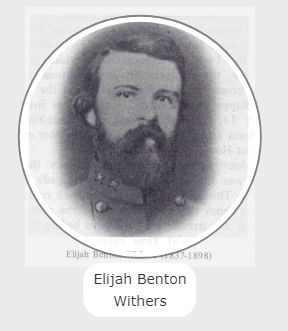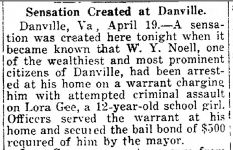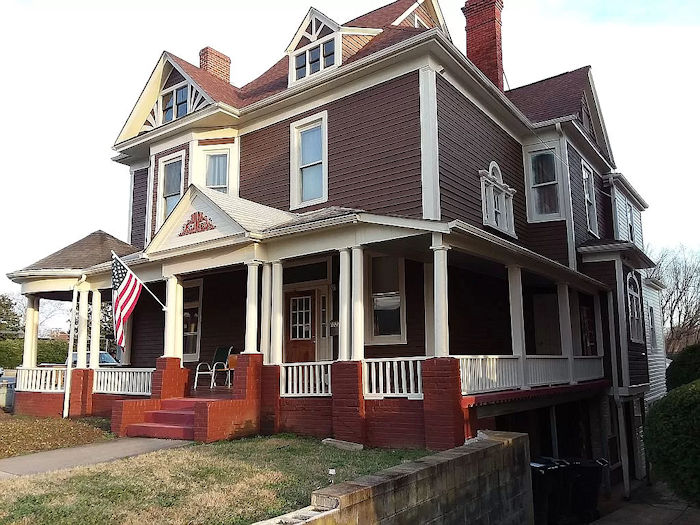It’s difficult to say precisely when the house at 1021 Main Street was built. The earliest records we have found indicate that two parcels of land, including a triangular lot that fronted Holbrook Avenue, were purchased W. Price, E.B. Withers, and G.W. Stokes in 1875 for a sum of $2,000, an impressive price for a lot of undeveloped land, which suggests that a dwelling of some kind must have been there even at that early date. Indeed, on the Beers Map of 1877, a triangular section of land appears, upon which are two dwellings, one of which is labelled as the home of N.B. Norman. The 1880 census indicates a Banks Norman living at or near the address (the 1880 Census does not indicate house numbers) and that he was living with his brother, William Norman. Both gentlemen were dealers in tobacco.
 In 1888 that same lot of land was sold to J.J. O’Donnell for $3,700. The 1890 city directory certainly indicates that Mr. O’Donnell was living there by then. N.B. Norman’s name, however, is also listed. So were they residing together, or had a second dwelling been built?
In 1888 that same lot of land was sold to J.J. O’Donnell for $3,700. The 1890 city directory certainly indicates that Mr. O’Donnell was living there by then. N.B. Norman’s name, however, is also listed. So were they residing together, or had a second dwelling been built?
James J. O’Donnell was born in 1838 in New York and was employed as a plumber. He apparently did not stay in Danville long as he is identified in the 1900 census as having relocated to Newport News, Virginia. Indeed, in 1898, he sold the house to William Young Noell.
Mr. Noell, a tobacconist, was born in December of 1854 in Oak Hill, North Carolina, the son of James D. and Virginia Penick Noell. Educated in Halifax, he came to Danville in his twenties and found employment with the dry goods dealer Sol Fleishman. He later took employment with Estes and Wooding, another dry goods business, of which Mayor Harry Wooding was a partner. He eventually quit the dry goods business in favor of tobacco and found employment with Charles Conrad and Sons, for whom he served as a representative in the western states where he worked to build up the demand for bright leaf tobacco. He went on to form a partnership with John E. Hughes in the wrapper business before forming a partnership of his own with his son Eugene, finding much success in that enterprise due to the contacts he had made while working for Conrad. His many years work in the tobacco industry led to his eventual election as president of the Danville Tobacco Association.
 Mr. Noell lived most of his life as a respected man of business, but in 1921, the tide turned for him when he was accused of assaulting a twelve-year-old girl whom he had allegedly lured into his warehouse on the corner of Lynn and Loyal Streets. According to the victim, Lora Gee, Mr. Noell had stopped her on the sidewalk as she was attending to an errand from her mother, who had sent her to fetch something at a nearby store. Mr. Noell claimed he was in need of a stenographer, and perhaps he might hire her. As if his intentions were to interview her for the position, he enticed her inside and proceeded to give her a tour of his tobacco factory. The tour culminated on the top floor, where, in a sheltered corner, he attempted to kiss her. As she objected, his advances took on a more sinister and determined approach. She objected and finally freed herself, and, to console her, he offered her fifty cents to keep quiet about the matter. She then left the factory. In tears, she made her way home and was stopped by Mr. S.J. Davis who inquired as to what was wrong. She was persuaded to tell him what happened. In consequence, he advised her to return straight home and to tell her mother all that had happened. She did, and her mother reported the event to the police, who arrested him that night at his Main Street residence on charges of assault.
Mr. Noell lived most of his life as a respected man of business, but in 1921, the tide turned for him when he was accused of assaulting a twelve-year-old girl whom he had allegedly lured into his warehouse on the corner of Lynn and Loyal Streets. According to the victim, Lora Gee, Mr. Noell had stopped her on the sidewalk as she was attending to an errand from her mother, who had sent her to fetch something at a nearby store. Mr. Noell claimed he was in need of a stenographer, and perhaps he might hire her. As if his intentions were to interview her for the position, he enticed her inside and proceeded to give her a tour of his tobacco factory. The tour culminated on the top floor, where, in a sheltered corner, he attempted to kiss her. As she objected, his advances took on a more sinister and determined approach. She objected and finally freed herself, and, to console her, he offered her fifty cents to keep quiet about the matter. She then left the factory. In tears, she made her way home and was stopped by Mr. S.J. Davis who inquired as to what was wrong. She was persuaded to tell him what happened. In consequence, he advised her to return straight home and to tell her mother all that had happened. She did, and her mother reported the event to the police, who arrested him that night at his Main Street residence on charges of assault.
The charges resulted in several trials and two years of litigation. The first trial ended in a hung jury. In the second trial, Noell was found guilty of simple assault (a drop in charges from the much higher one he had originally been brought to trial for) and was sentenced to twelve months in prison and a fine of $300. He immediately appealed, but the case was set aside by the state Supreme Court due to contention that Mr. Noell’s rights had not been preserved because Miss Gee had never been returned to the factory to prove that her screams could not be heard. There was, indeed, a witness, but she was deemed too young to testify. The failure of that case resulted in a civil case brought about by Mrs. Gee on behalf of her daughter, suing Mr. Noell for $30,000. Miss Gee was awarded $4,000 in that trial. Two years after the incident, the final trial concluded with a plea of “Nolo Contendre” (I do not contest) and a fine of $500 which was immediately paid by the wealthy but disgraced tobacconist. By then, young Lora (still young at 15) had married and was exhausted by the whole affair. Not only that, but the trials had sullied her name, and she and her husband therefore decided it was best to drop the matter and move away to start their lives afresh somewhere else.
On the 10th of April 1924, just shy of three years from the date of the assault perpetrated against young Lora Gee, rooms adjacent to Mr. Noell’s factory caught fire. The fire started in rented rooms above the next-door grocery store (possibly the store Lora was supposed to have been going to when she was waylaid by Mr. Noell). The fire never reached the warehouse, but water used to douse the blaze penetrated the factory where some hanging tobacco was ruined.
By that time, Mr. Noell had relocated to 240 West Main Street. On June 4, 1925, he succumbed to what The Bee described as a complete physical breakdown.
 Mary Estes, a widow, was next to live in the house. She ran the large home as a boarding house. According to a recent owner, Micah Robinson, it was Mrs. Estes who added onto the rear of the home.
Mary Estes, a widow, was next to live in the house. She ran the large home as a boarding house. According to a recent owner, Micah Robinson, it was Mrs. Estes who added onto the rear of the home.
Maddie Lumpkin Lynch continued the boarding house tradition from 1943 until her death in 1964, when the house was passed down to her children.
The Lynch family sold home nine years later to Alcoholics Counseling Services of Danville. The organization ran the house as Hope Harbor and added another extension, complete with its own kitchen, bathroom, and sleeping quarters, bringing the total square footage of the property in excess of 7,000 square feet.
